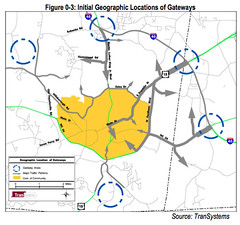Tomorrow is the second public information session on the Town of Chapel Hill's Long Range Transit Plan.

James Carnahan wrote a great opinion piece in the Carrboro Citizen last month about the LRTP and the importance of public engagement with the questions it raises. Here's just a bit, I recommend reading the entire thing:
This document will play an important role in future investments we make in transit infrastructure, and thus in our ability to reduce our greenhouse gas emissions, increase the walkability of our towns and enhance the vitality of our local economy.
The LRTP envisions a “concept service plan” featuring six “gateway” nodes at our boundaries, where travelers would be intercepted and transferred to a “robust transit system” with services enhanced throughout Chapel Hill and Carrboro. “Travelers should be able to park their automobiles at the city boundaries and use transit to meet virtually all of their mobility needs” (pg. 5-1). It appears to be mainly a congestion-mitigation plan, intended “to divert automobile drivers to transit” (pg. 3-10).
It calls for parking structures costing $200 million at two of the six proposed gateways. Yet providing parking only encourages continued driving. If we had this $200 million to spend, why not spend it on the transit technologies that replace driving?
Does this LRTP effectively address the global challenges of peak oil (much higher travel fuel prices) and climate change (the need to restrict burning of fossil fuels)? Do the data used and the outcomes imagined accurately anticipate the choices people will be making in the face of the emerging global context, about how they travel and where they live? For the year 2035, the plan forecasts 744,300 daily auto person trips in the high-investment scenario that has only 56,300 people riding transit. Will so many of us still be driving if gas is selling for, say, $8 a gallon in 2035?
- Carrboro Citizen: Make your voice heard on transit, 12/17/209
Here's a bit from the plan's Executive Summary:
The building blocks for the LRTP are based on three basic findings. These findings are crucial foundations to the plan:
1. Analysis of 2035 travel demand suggests that six main corridors will be used by commuters to access the Chapel Hill-Carrboro community. The traffic levels in these corridors can justify an investment in a higher order of public transit.
2. Future travel demand necessitated the need for improved transit services
- Three service delivery concepts may be appropriate for higher level transit service. These include light rail (LRT), bus rapid transit (BRT) and enhanced express service (EEB). Light rail was found to be cost prohibitive if used as a Gateway service. However, this Plan recognizes LRT as a potential regional service that would serve some of the gateways while going beyond them to connect with Durham and Wake Counties.
- Expanded local bus service will be necessary to support the Gateway services. The expansion of local transit services will compliment the proposed Gateway services, providing improved access to the Gateway stations and increasing local mobility.
3. Transit supportive land use policies, including parking policy need to be implemented along major
transportation corridors and in the downtown to allow the preferred service concept to realize its maximum potential in attracting additional transit trips.
You can check out the plan, includinga 16-page executive summary with lots of maps (yay, maps!) at http://townofchapelhill.org/index.aspx?page=1284
And if you can't make it to the information session in person, the Town is also inviting comment by phone, fax, e-mail, and even snail mail. I'm going to try to go, so if you have any good ideas share there here and I'll raise them up at the meeting (if I agree).
More Information:
Issues:



Comments
Looking at the big version
of the map there I notice that I live outside of the core of the community (yellow area) right along with U Mall, Whole Foods, the Library, Trader Joes, and Rams Plaza. Not saying this is a good or bad thing, just my first instinct when looking at a map of the area is to find where I am on it.
about the plan
The point you make, Jake, makes me want to emphasize that this particular plan really is an effort to devise a way to gather people at different 'gateways' on the outskirts of town and funnel them into the downtown medical school/hospital/university/Franklin Street area. That was repeatedly mentioned at the first transit meeting which was held last month (maybe November). There's precious little in the plan about intra-town transportation. So while this is an important discussion, and an important aspect of town public transportation, it's purposely limited in an important way.
Future Futility?
It is both easy and fun to trash long range plans and few take to heart the disclaimer of professional planners who ethically must base their projections on current realities. If you can't imagine the changes that could occur between 2010 and 2035 (I won't be here to find out), you need only contemplate the changes that happened between 1910 and 1935 or 1985 and 2010.The car is how we go now and when it comes to "going" it is hard to imagine what level of convenience would replace this mobility. More importantly is whether we'll have any choice and what of that we would have based on wise decisions we make now.If rail is a future choice for Chapel Hill - Carrboro (Hillsborough) we must secure/maintain corridors/station sites now and promote the density that would sustain the service. I always think of Switzerland where many of its cities, close to our size, implemented trolley service as extensive as our bus service. If they could not secure open right of way they put the trolley tracks down the middle of streets (cars have to yield to trolley). In Basil you can go within a couple of blocks of anywhere with bus service to non-rail served employment sites. The high cost of housing and property taxes in Chapel Hill and Carrboro assures us that our plans must accommodate vast numbers of commuters coming to work, daily, from further and further away. Take the Metro from Rockville, Maryland to Medical Center (Bethesda) and see our future.